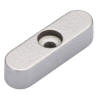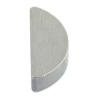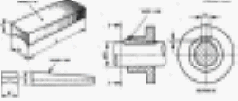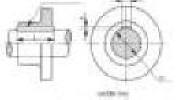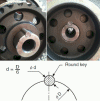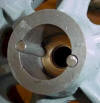|
Type of Keys |
|
Videos |
|
Four main shaft keys are
available: sunk key, saddle key, tangent key, and Round key.
Each has different characteristics and load-bearing
capabilities; hence the correct shaft key must be selected
for the application based on its characteristics and
benefits.
|
Key type |
Shaft key usage |
|
Sunk keys |
Rectangular keys |
A rectangular key is
generally used for shaft diameter between 1” (25
mm) and 20” (500 mm) |
|
Generally, these have a reduced effect on the
shaft due to its shallow keyway depth |
|
Square keys |
A square key is used if
the deeper key depth is required to transmit
torque. But ensure the weakened shaft can
support the load. |
|
A square key is used for shafts diameter up to
and including 1” (25 mm)Parallel sunk keys are
widely available and are one of the easiest to
install |
|
Parallel sunk keys |
|
If possible, use set screws in the hub to hold
it down to stop it from sliding out during
operation |
|
Gib head keys |
These are very similar to
rectangular/parallel keys, but it is easier to
remove due to the head |
|
Feather keys |
Feather keys allow the hub
to move axially while transmitting the
rotational torque |
|
Woodruff keys |
Use it for lower loads and
can accommodate any tapered shafts/hub
connection. |
|
Saddle keys |
Only use it for very light
unidirectional loads |
|
Tangent keys |
Can be used on slow
bi-directional large torque applications. |
|
Not recommended for high frequency directional
change |
|
Round / Circular Keys |
Used only for very low
torque and speeds |
|
It can be fitted by drilling and reaming the
shaft and hub assembly together |
|
Key diameter to be approximately sixth of the
shaft diameter |
|
|
|
|
|
|
Rectangular keys, as shown, are wider than
their height and are sometimes called flat keys. These are
used on shafts up to about 500 mm or 20″ in diameter. The
extra key width allows it to transmit greater torque without
increasing the depth. An increase in depth means a weaker
shaft due to a reduction in effective shaft cross-sectional
area. |
|
|
|
|
|
Square keys
are small bars
of any length with similar height & width. They are inserted
between a shaft and a hub to prevent relative rotation. A square key is used if
the deeper key depth is required to transmit
torque. But ensure the weakened shaft can
support the load. |
|
|
|
|
Parallel keys
are a critical component used to efficiently convey shaft
rotation to gears. These items are used in machine tools,
automobiles, construction equipment, food machinery, pumps,
and more. Parallel shaft keys come in different names
depending on the vendor and industry in which they are used.
They are variously referred to as parallel shaft keys,
machine keys, and shaft keys, but these all refer to the
same product.
These items are used in machine tools, automobiles,
construction equipment, food machinery, pumps, and more. |
|
|
|
|
|
Gib head sunk keys are very similar to
rectangular/parallel keys, but it is easier to
remove due to the head |
|
|
|
|
|
Feather Key
is a rectangular key that connects the keyways of a gear,
pulley, or shaft's hub to another keyway. It's permanently
fixed in one keyway and can slide freely in the other,
allowing the shaft to drive the hub or be driven by it at
various positions along the shaft. Feather keys are also
known as spline keys |
|
|
|
|
|
Woodruff keys, also known
as half-moon keys, are semi-circular discs that are used to
connect machine parts to rotating shafts and spindles. They
are inserted into key seats that are created by a woodruff
key cutter or arbor cutter. The key prevents gears, hubs, or
other components from moving independently of the shaft or
spindle. Woodruff keys are often installed into recessed key
seats cut into the shafts. |
|
|
|
|
|
A saddle key
is a type of shaft key that is installed on the surface of a
machine shaft and fits into a keyway in the shaft. Saddle
keys are concave and grip the shaft by friction, resisting
relative motion and transmitting torque. |
|
|
|
|
|
Tangent keys
are a pair of rectangular keys that are placed at right
angles to each other on the shaft, and tangent to the
shaft's surface. Each key can only withstand torsion in one
direction. Tangent keys are used in large, heavy-duty
shafts. |
|
|
|
|
|
|
|
Round keys,
also known as pin keys, Scotch keys, or Dutch keys, are
cylindrical keys that fit into holes drilled partly in the
shaft and partly in the hub. They are available in both inch
and metric sizes and are offered in carbon steel and
stainless steel. |
|
|
|
|


















